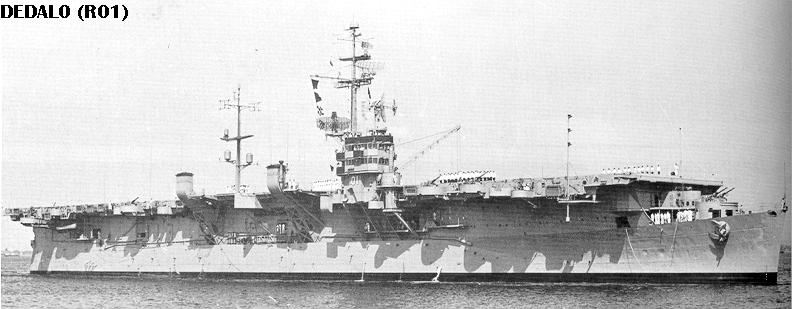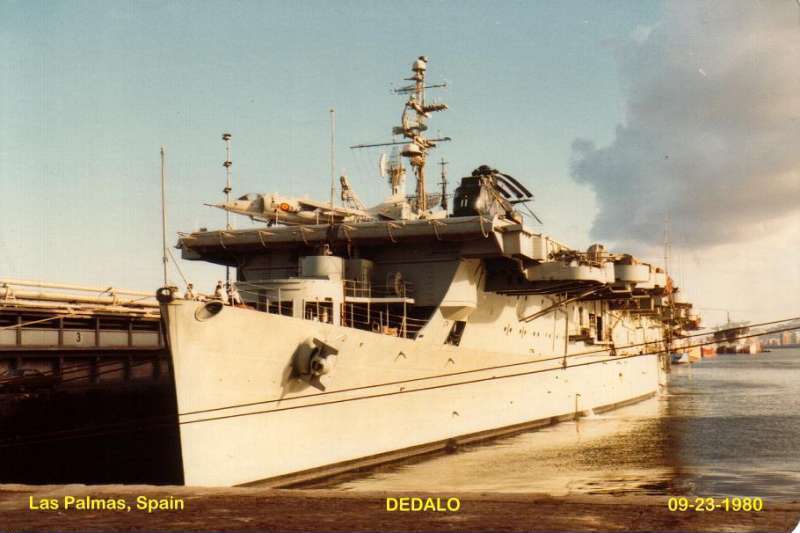When US Navy made a leasing of USS Cabot in the 60's to the "armada espanhola" probably think they will use it as a helicopter carrier. But Spain had different objectives, so in 1972 after a trial with the VTOL plane, they buy 10 Av8A from USA that use from the wooden deck of Carrier Dedalo, since 1976 (The Gibraltar Problem was the main reason for the period of 4 years waiting, because british have to agree with the aquisition). The sucess was fair enought to make Av8 matador famous and to give to world seven light carriers in the years after, were the little "fighter" was the main star. When Sea Harrier give a blast to Argentina, much of the experiênce was made in about 6 years of use in Spanish Navy. Today, several Navy's like the Italian or the Spanish, still uses the Harrier.
 |
| Fig.1- F6 Helcat landing on USS Cabot (CVL - 28) in 1944. |
Carrier Dédalo was a World War II veteran named in time USS Cabot, and fight the last 3 war years in the Pacific as a escort/light carrier, with Hellcat fighters and Avenger torpedo bombers. After the war the ship was a trainer carrier from 1948 to 1955 and after 12 years in reserved, was loaned to Spanish Navy in 1967 and sold in 1972 to Spain. As a nation part of NATO, USA invested hard in Spain (that time and t'ill the 80's with Franco was main head of governement), and a less few in Portugal (with Salazar as leader), that was also in a war in African provincies (Portugal was fighting the comunist guerrilhas in Angola, Mozambique and Guinea, but America never supported the portuguese like South Vietnam or any other country in a fight against comunism, because for America portuguese were colonialist). So, the major weapons were to the Iberian Península partner, and the few that was give to Portugal was NATO armament so there was a proibition of use it in Africa.
 |
| Fig. 2 - Another photo of USS Cabot in the last year of WWII (February 1945). |
After the war US Navy had the Essex Class and Enterprise has main carriers (Midway was on the way), with a huge number of escort and light carriers, much of them to small or expensive for other nations. USA used them for transportation, vertical assault, comand ships and training, but a few were in the active service. Only one or another navy had the post war capacity to operade a carrier like France, and even Spain, and the reasons were the devastation of war, NATO "sindrome" and also the short budget, were a carrier (even small) was a resource blast in crew and money. So, only by the late 60's Spanish Navy was in conditions to have a carrier, but only with helicopters like the Sh-3, Oh-6, Huey and later the Cobra. But the problem of making the security of the Task Force ships was that in a small carrier only a light prop or a VTOL, tested by Us Navy and the British. But the fighter was a mix of USA/UK tecnology and there was a matter named Gibraltar.
 |
| Fig.3 - R01 Dedalo when leasing by US NAVY to Spain in 1967. |
Even so, the tests were made and partnership between Dedálo and Av8 had good potencial. A buy in 1972 was only completed in 1976 (again Gibraltar), but was a success from the first day that operations started, since with a small space in deck and at the hangar, Harrier was easy to ascend, land and stick to hangar. There was no radar at the plane but was important to give protection to the fleet with guns and short range missiles (the fighter had orientation of ship's radar), against other planes, in a reality were only a few fleets have carriers (France, Britan, USA, USSR and in the last came Spain). ASW missions were made by helicopters and in this time carriers with VTOL planes had no AEW system (after the Falklands in 1982 the RN converted Sea King helicopters to the AEW missions, with Spain doing the same years later).
 |
| Fig. 4 - Has we see Carrier Dedalo had 6 helicopter landing points when delivery to Spanish Navy. After the upgrade in 1967 Us transfer him to Spain |
Of course not everything was fine. Harrier was never a easy fighter to make operations and a small carrier has a few space. With bad weather the problem increases and in that time sensors to help with the operations in a non convencional carrier were few (besides the AV8 was a jet with not much electronic and expensive to use). But again the earnings were more than the losses, with Spain, UK and Italy making light carriers to operate with VTOL jets (Thailand and Russia also, but this last one were much larger), With Falklands war came the prove that concept was valid. Not only Sea Harrier (the version of Harrier to Royal Navy), make a significant role of missions, but also the Harrier Gr3 (atack version of Harrier to RAF, a slightly version of Gr1/Matador), was a sucess, with atack missions in the islands and also with AIM9l sidewinder missiles, in the defence of the fleet.
 |
| Fig. 5 - A visit by spanish civillian to Carrier Dedálo in the 70's. |
The Spanish Navy continued operations with Carrier Dedálo up till 1989. New Carrier "Principe del Astúrias" came in service by 1988, and there was no budget to two carriers. Only one Matador was lost in a acident (and three Bell AB212 ASW helicopters), in a ship who made operatios with Cobra, SH55, SH3 and also OH6 helicopters. Since 1976 Dedálo and Spanish Navy were the target of studie in this mater by a number of other navy staff, like UK, Italy and of course also USSR. The main reason was to Italy and USSR, have the theory to operate for the first time carriers with VTOL fighters, and Royal Navy to use the light carriers with Sea Harrier, insted another contemporary version of the more expensive Carrier Ark Royal. Harrier was tested in french Helicopter Carrier "Joanne D' Arc", the "russian version", Yak 36Mp/38 in the "brother" Moskva and with the experiênce of americans and spanish, was an idea that came to life, in final 70's and in the starting of the 80's (with Kiev class).
 |
| Fig. 6 - Helicopters like Sea King and Cayuse in the Carrier Dedálo. There's no Harrier in image but the land marks are there. Probably here delivered more late |
For the Spanish Navy, the experience of Carrier Dédalo and his air wing was so positive that soon in the 70's the plans to make a new and bigger carrier were made. "Principe del Astúrias" was a concept that came from Admiral Zunwalt Control Carrier, tested in USS Guam, with Harrier fighters and helicopters, made a function like old ASW carriers in Us Navy, that was to open the way to the main carrier and his group against russian submarines. A less expensive carrier was more "easy" to lost but the concept was ended because US Navy had feer of lose budget to principal carriers. But the concept was valid, in fact, Falklands was the combat prove of that, and after the war this type of carrier was used for more than 30 years. Today, Italy, Thailand (Av8 was retired, only helicopters) and Spain (with Juan Carlos class), had Harrier and AV8 in operation from their carriers (maybe Australia will be the next with is HMAS Camberra, but with F35B), and USMC operate them from his Landing Platform from ancient Tarawa to Wasp. And all came with Dédalo, the first light carrier with VTOL fighters in full service. To bad was scrap and not a museum (was donate to a american instituction but without money they lost the ship).
 |
| Fig.7 - Harriers in operations at Sea with Dédalo at the botom. |
 |
| Fig.8 - Admiral Zunwalt control Ship. Tested in Iwo Jima class the concent was not used by us Navy, but several aplications were made abroad. Spanish was the first with Dédalo, but later wil buid "Principe del Astúrias", a copy from this american project. |
 |
| Fig.9 - Carrier Dédalo (R01) at sea, with Av8 Matador in operations. |
 |
| Fig. 10 - AV-8A Matador armed with two sidewinder missiles. |
 |
| Fig. 11 - Carrier Dedalo enter in the Port with most of the aerial group on the deck. |
 |
| Fig. 12 - Carrier Dedálo at Las Palmas in 1980. |
 |
| Fig. 11 - A toneaux- AV-8 Matador is an Harrier Gr1 made for naval operations in spanish Navy. The British used also the type in their ships, and made the Sea Harrier to their Carriers. No guns see in image. |
_USS_Raleigh_(LPD-1)_and_USS_Saipan_(LHA-2)_at_Rota_1982.JPEG) |
| Fig. 12 - Another great photo of Dédalo in is Base, Probably some time after gone to scrap, since there's no AA 40 mm Guns. An american LHA from Tarawa class (USS Saipan LHA 2) is see also. |


















Sem comentários:
Enviar um comentário